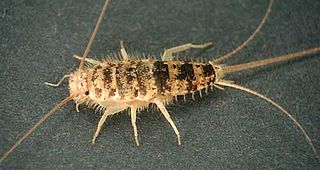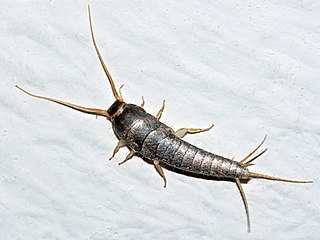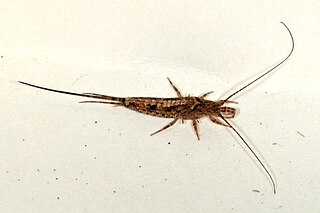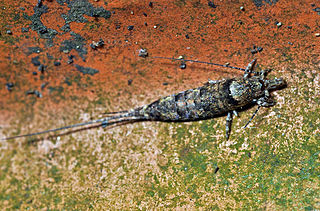
Drassodes is a genus of ground spiders that was first described by Niklas Westring in 1851. They are brown, gray, and red spiders that live under rocks or bark in mostly dry habitats, and are generally 3.8 to 11.6 millimetres long, but can reach up to 20 millimetres (0.79 in) in length.

The Machilidae are a family of insects belonging to the order Archaeognatha. There are around 250 described species worldwide. These insects are wingless, elongated and more or less cylindrical with a distinctive humped thorax and covered with tiny, close-fitting scales. The colour is usually grey or brown, sometimes intricately patterned. There are three "tails" at the rear of the abdomen: two cerci and a long central epiproct. They have large compound eyes, often meeting at a central point. They resemble the silverfish and the firebrat, which are from a different order, Zygentoma.

Lepismatidae is a family of primitive wingless insects with about 190 described species. This family contains the two most familiar members of the order Zygentoma: the silverfish and the firebrat. It is one of five families in the order Zygentoma.

Zygentoma are an order in the class Insecta, and consist of about 550 known species. The Zygentoma include the so-called silverfish or fishmoths, and the firebrats. A conspicuous feature of the order are the three long caudal filaments. The two lateral filaments are cerci, and the medial one is an epiproct or appendix dorsalis. In this they resemble the Archaeognatha, although the cerci of Zygentoma, unlike in the latter order, are nearly as long as the epiproct.

Ctenolepisma lineatum is a species of insect of the order Zygentoma. It is similar to the closely related silverfish but can be distinguished by being rather stouter and less shiny with all appendages noticeably longer. The abdomen is often marked with dark brown lines and the species is sometimes called four-lined silverfish.
Ctenolepisma almeriense is a species of primitive insect of the order Zygentoma. Members of this species were once attributed to the widespread species Ctenolepisma lineatum but there are small but consistent differences which mark this as a separate species. It is found exclusively in south-eastern Spain, on Mediterranean slopes of the provinces of Alicante, Almería, Murcia and Valencia.

The silverfish is a species of small, primitive, wingless insect in the order Zygentoma. Its common name derives from the insect's silvery light grey colour, combined with the fish-like appearance of its movements. The scientific name indicates that the silverfish's diet consists of carbohydrates such as sugar or starches. While the common name silverfish is used throughout the global literature to refer to various species of Zygentoma, the Entomological Society of America restricts use of the term solely for Lepisma saccharinum.
Neoasterolepisma is a genus of primitive insects belonging to the family Lepismatidae. Many species live with ants.
Charimachilis is a genus of the family Machilidae which belongs to the insect order Archaeognatha. They are found in southern and eastern Europe.
Lepidospora is a genus of silverfish in the family Nicoletiidae.

Lepismachilis is a genus of jumping bristletails in the family Machilidae. There are more than 20 described species in Lepismachilis.

Trigoniophthalmus is a genus of jumping bristletails in the family Machilidae. There are about 11 described species in Trigoniophthalmus.
Trinemophora is a genus of silverfish in the family Protrinemuridae. Four species are currently known, two of them being Trinemophora schaefferi(Silvestri, 1905) from Chile and Trinemophora bitschiana(Wygodzinsky, 1959) from Turkey.

Tricholepidion is a genus of wingless insect belonging to Zygentoma, with only a single described species T. gertschi, native to the northern coast of California in Western North America. It lives under dead bark and in rotting wood of conifers in mesophytic forests. It is alternatively considered the only living member of the family Lepidotrichidae, which also includes Lepidotrix from Eocene aged European amber, or the only member of the family Tricholepidiidae. The taxonomic position of Tricholepidion is uncertain, in some molecular phylogenetics studies it has been recovered as less closely related to flying insects (Pterygota) than the rest of Zygentoma is, rendering Zygentoma paraphyletic. Each compound eye contains ~40 ommatidia, and they have three ocelli. Scales on the body are absent. Unlike Archaeognatha and the other families of Zygentoma, which have three- and sometimes two-segmented tarsi, they have five-segmented tarsi like many winged insects.
Thermobia aegyptiaca is a species of silverfish in the family Lepismatidae. The species was described by Hippolyte Lucas in 1840 based on specimens collected in Egypt. Thermobia aegyptiaca is distributed in Africa and the eastern Mediterranean Basin.
Ctenolepisma terebrans is a species of silverfish in the family Lepismatidae.

Ctenolepisma longicaudatum, generally known as the gray silverfish, long-tailed silverfish or paper silverfish, is a species of Zygentoma in the family Lepismatidae. It was described by the German entomologist Karl Leopold Escherich in 1905 based on specimens collected in South Africa, but is found worldwide as synanthrope in human housings.
Jiří (Juraj) Paclt was a Czechoslovakian botanist and entomologist. Although born and raised in the Czech part of Czechoslovakia, he spent the majority of his work life in the Slovak part that later became Slovakia. His scientific work is characterised by a wide scope of interests and activities, ranging from botany over mineralogy to entomology.
Sceletolepisma is a genus of primitive insects closely related to the silverfish and firebrat but less reliant on human habitation, some species being found both indoors and outdoors and some found exclusively outdoors. The genus is distributed nearly worldwide in warm regions.













